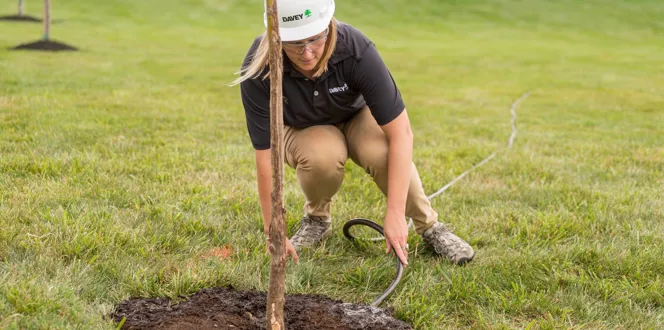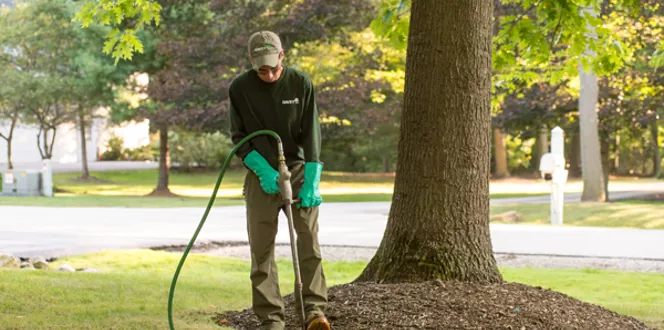Searing temperatures can catch you by surprise, especially after cooler days or rainy seasons.
While a heat wave can expectedly cause struggling plants to wilt, it can even set back well-established plants and landscape shrubs.
Mother Nature’s hot flashes may be out of your control, but you can help tackle the rising temperatures by recognizing heat stress symptoms and learning how to treat heat-stressed trees.
Let’s look at some things you can do immediately to better handle unexpected warm spells, so your plants and trees survive the heat wave.
Signs & Symptoms Of Heat Stress On Trees
Most plants grow best in temperatures ranging from 59 degrees to 86 degrees Fahrenheit.
Plant growth tends to slow when temperatures rise over 90 degrees Fahrenheit and lingers for longer periods. That’s when you might begin to see heat stress symptoms. These symptoms can amplify when temperatures are over 104 degrees Fahrenheit. The National Weather Service describes a heat wave as a period of abnormally hot weather generally lasting for several days. For plants, an important component of heat waves is that they usually accompany drought. The combination of heat and a lack of water results in the symptoms we can observe in the landscape.
You can think of it as similar to heat stroke in people.
Here are some of the symptoms you're looking for: If any of the mentioned symptoms were occurring before the heat wave, something else may be causing it. You should contact your local arborist for a consultation.
- Leaf rolling and cupping - Wilting
- Scorched leaf edges
- Dead leaves or leaves falling off – Some trees such as hackberry are more prone to this and may enter summer dormancy if the heat is severe
- Little or no new growth - Sap oozing from the trunk - This can happen on the south or southwest side of the trunks where the sun’s heat burns the tree bark.
- Blossom and fruit drop - Many ornamental plants will drop buds or flowers after prolonged exposure to high temperatures as a way to conserve resources.
Effects Of Heat Stress On Trees
Extreme heat can impact many functions of a tree.
Looking at the leaves, photosynthesis is reduced, leaves may fall off, and the growth rate of the remaining leaves decreases.
Concerning the whole tree, heat stress can slow overall growth.
What Are The Long-Term Impacts?
While some tree species are more tolerant than others to heat stress,. prolonged heat exposure can certainly exacerbate existing issues.
At high temperatures and without sufficient water, trees eventually reach a point where they can’t take up enough water from the soil to support the whole tree canopy. As temperatures escalate and available water becomes limited, the tree closes stomates on the leaves which results in reduced photosynthesis and slowed growth,
This can weaken the tree and lead to pest, disease infestation, and even tree mortality.
If You Are Experiencing An Unexpected Heat Wave In Your Area, Here Are Some Immediate Actions
You might be wondering how to reduce heat stress in plants as you notice some of these heat stress symptoms.
Follow these tips when you see symptoms of heat stress:
- Water deeply, but infrequently. A weekly, deep soak is much better than just a little water every day. But when watering, remember to follow any water restrictions in your area pertaining to lingering drought or heat. Allow the soil to drain between waterings. Don’t let it stay soggy or muddy.
- Be aware that there is a difference in watering needs between young and old trees. Newly transplanted or younger trees require more water to become established – approximately 5 to 15 gallons of water each week, particularly between April and October.
- Water the roots of the tree by applying water directly to the soil (as opposed to overhead irrigation); this way you don’t lose any water to evaporation.
- Refresh the mulch over your tree’s root zone. If there is no mulch, a 2- to 3-inch layer can help insulate the roots from heat and minimize moisture loss in the soil. Keep mulch away from the tree trunk as mulch against the bark can lead to fungal problems on your tree.
- If you have an automatic irrigation system, check to see how much water is being put out and where it is going. It may be necessary to adjust the system so it is not putting out too much or too little water in one area. Sprinkler heads should also not be hitting trees directly with water.
FOLLOW THESE DROUGHT-TOLERANT LANDSCAPE IDEAS.
CONTACT YOUR LOCAL DAVEY ARBORIST IF YOU’RE EXPERIENCING A HEAT WAVE IN YOUR AREA.





